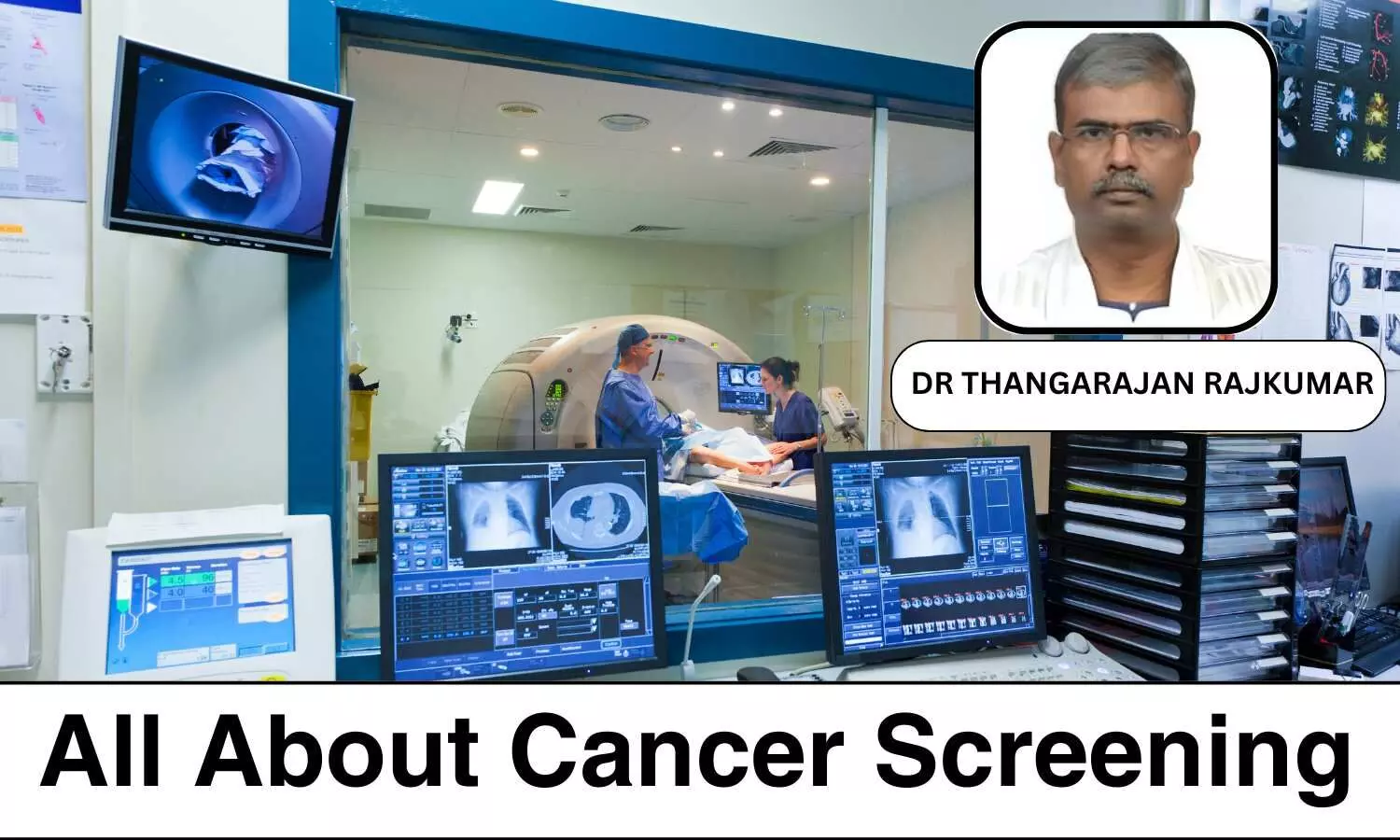Cancer Screening – What to expect and why it matters? - Dr Thangarajan Rajkumar

In 2022, India witnessed 14,61,427 new cancer cases, with expectations of a further 10% increase by 2025. Notably, lung cancer prevails as the most common among men, while breast cancer ranks highest among women.
However, the grim reality persists, nearly 60 to 75% of cancers are detected at an advanced stage, greatly compromising cure rates. Detection in the early stages significantly boosts cure rates to nearly 100%. Cancer screening emerges as a critical approach for early detection, offering hope for improved outcomes.
Cancer screening is done before a person has any symptoms, and it is an intensive process if the screening is done at the population level, needing physical and financial resources.
Hence, the primary focus of cancer screening in a country will be to identify the common cancers seen in its population and then develop a strategy to do the screening.
Another, important caveat is that the screening test should have high sensitivity (able to identify all the cancers and precancers) and high specificity (able to identify a normal subject, as normal). If a test has low sensitivity, it will result in missing cancers (false negative) and if it has low specificity, it will label a normal subject as having cancer, leading to unnecessary investigations and mental stress (false positive).
Common cancers and cancer screening tests strategies
1. Oral cancer (men & women)
Oral cancers, prevalent in both men and women, are primarily linked to tobacco (in any form – chewing, smoking, gutkas etc.) and alcohol use. While chewing tobacco remains a predominant factor for women, urban areas is witnessing a rising trend of women adopting smoking.
Visual inspection of the oral cavity and palpation (feeling the oral cavity) using fingers is a simple screening procedure for assessing the risk. In a 15-year follow-up study, over 96000 subjects were enrolled in the intervention arm (4 rounds of oral visual inspection every 3 years) and over 95000 subjects in the control arm (1 round of screening).
There was 38% reduction in oral cancer incidence (95% CI 8-59%) and 81% reduction in oral cancer mortality (95% CI 69-89%) in tobacco and/or alcohol users adhering to four screening rounds, clearly showing the benefit especially in high-risk subjects.
2. Lung cancer
Presently, guidelines advise low-dose CT lung scans for people aged 50–80 who have smoked or used to smoke for at least 20 pack-years (as per American Cancer Society, one pack year equates to smoking one pack per day for a year).
However, it's essential to know that CT scans can identify both cancer and non-cancerous conditions, necessitating further invasive procedures for confirmation. A study among high-risk individuals showcased a remarkable sensitivity of 97% and specificity of 90%, underlining the efficacy of this screening approach.
3. Colo-rectal cancer (Large bowel cancers in men & women)
The American Cancer Society recommends screening for average-risk individuals starting at age 45 up to age 75 years.
Screening methods include stool examination for the presence of blood, which can be repeated every year or once every two years, or a colonoscopy (provides direct visualization of the large bowel).
If a colonoscopy yields normal results, it can be repeated once every 10 years.
4. Prostate cancer:
Prostate cancer, common among elderly men, progresses slowly, often surpassed by other health issues in those over 75 years of age. Screening typically starts from age 55-60 for men without a family history or of African American descent.
However, those with such history or of African American ethnicity can begin screening earlier, between ages 45-55. The screening is done using a blood test checking for levels of a protein in blood called Prostate specific antigen (PSA).
The protein can be elevated in infection of prostate or with benign enlargement of prostate called Benign Prostatic Hyperplasia (BPH). The blood test is to be coupled with Digital Rectal examination (DRE), wherein the clinician inserts a finger through the anus and feels the prostate, which lies in front of the rectum.
An elevated PSA with an abnormal DRE will warrant additional investigations like ultrasound. In highly suspicious lesions biopsy will need to be done. While screening isn't recommended after age 75 due to cancer's usually indolent nature, decisions should be based on a physician's guidance.
5. Breast Cancer:
Breast cancer stands as the predominant cancer among Indian women. It's recommended that self-breast examination begins at 25 years, should do it a few days after the period ends or on a fixed day post-menopause. Women over 40 should undergo clinical examination, ultrasound, and mammography, with those above 45 it is advised to have yearly ultrasound and mammograms.
In hereditary cancers, an abnormal gene is copied from either parent to increase the risk of cancer. Since all the cells in the body would have the abnormal copy, testing the DNA derived from blood cells will be an easy way to detect these disease-causing mutations also called germline mutations.
In women with family history of cancer it would be worthwhile doing testing for germline mutations in genes associated with breast cancer such as BRCA1, BRCA2. In men with BRCA2 and BRCA1 mutations, risk for male breast cancer is increased by 6% and 4% respectively.
If a disease-causing mutation is identified, screening can begin as early as 25 years of age. Mammograms will be less effective in young women with dense breasts; hence, MRI is advised yearly for women between ages 25 and 29.
In women aged 30 and above, the current recommendation is to alternate MRI breast scans with mammograms, every six months, for this high-risk group.
6. Cervical cancer:
Human Papillomavirus (HPV) stands as a major risk factor for cervical cancer development. HPV vaccination, targeting the two most common subtypes—HPV16 and 18—aims to protect against infection.
Vaccination is recommended after 9 years of age, with two doses for individuals between 9 and 15 years, and three doses for those aged 15 to 25. The vaccination helps prevent infection by these high risk subtypes, which account for over 90% of cervical cancer.
Screening for cervical cancer involves HPV testing or Pap smear, starting at 25 years of age for sexually active women, and continuing up to 65 years if no precancerous lesions have been detected previously. HPV testing is conducted once every 5 years, while Pap smear tests can be repeated every 3 years, provided they yield normal results.
Pros and Cons of screening
Pros:
Early detection of cancer or pre-cancer, leading to improved chances of complete cure.
Cons:
- False positive results may prompt unnecessary investigations.
- False negative results can provide a false sense of security, potentially leading to delayed diagnosis.
Clinician's responsibility:
- Choose appropriate tests.
- Explain false positive and negative rates to ensure informed decision-making by the individual undergoing screening.
Cancer screening is crucial for detecting and tackling cancer early. Informed choices, early screening and detection, tailored strategies, and advancements in technology can greatly improve outcomes and reduce the burden of this disease.


